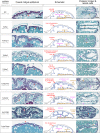Localized efficacy of environmental RNAi in Tetranychus urticae
- PMID: 36042376
- PMCID: PMC9427735
- DOI: 10.1038/s41598-022-19231-3
Localized efficacy of environmental RNAi in Tetranychus urticae
Abstract
Environmental RNAi has been developed as a tool for reverse genetics studies and is an emerging pest control strategy. The ability of environmental RNAi to efficiently down-regulate the expression of endogenous gene targets assumes efficient uptake of dsRNA and its processing. In addition, its efficiency can be augmented by the systemic spread of RNAi signals. Environmental RNAi is now a well-established tool for the manipulation of gene expression in the chelicerate acari, including the two-spotted spider mite, Tetranychus urticae. Here, we focused on eight single and ubiquitously-expressed genes encoding proteins with essential cellular functions. Application of dsRNAs that specifically target these genes led to whole mite body phenotypes-dark or spotless. These phenotypes were associated with a significant reduction of target gene expression, ranging from 20 to 50%, when assessed at the whole mite level. Histological analysis of mites treated with orally-delivered dsRNAs was used to investigate the spatial range of the effectiveness of environmental RNAi. Although macroscopic changes led to two groups of body phenotypes, silencing of target genes was associated with the distinct cellular phenotypes. We show that regardless of the target gene tested, cells that displayed histological changes were those that are in direct contact with the dsRNA-containing gut lumen, suggesting that the greatest efficiency of the orally-delivered dsRNAs is localized to gut tissues in T. urticae.
© 2022. The Author(s).
Conflict of interest statement
The authors declare no competing interests.
Figures







Similar articles
-
Environmental RNA interference in two-spotted spider mite, Tetranychus urticae, reveals dsRNA processing requirements for efficient RNAi response.Sci Rep. 2020 Nov 5;10(1):19126. doi: 10.1038/s41598-020-75682-6. Sci Rep. 2020. PMID: 33154461 Free PMC article.
-
The development of an egg-soaking method for delivering dsRNAs into spider mites.Pestic Biochem Physiol. 2024 May;201:105905. doi: 10.1016/j.pestbp.2024.105905. Epub 2024 Apr 10. Pestic Biochem Physiol. 2024. PMID: 38685227
-
RNAi-based reverse genetics in the chelicerate model Tetranychus urticae: A comparative analysis of five methods for gene silencing.PLoS One. 2017 Jul 12;12(7):e0180654. doi: 10.1371/journal.pone.0180654. eCollection 2017. PLoS One. 2017. PMID: 28704448 Free PMC article.
-
Beyond insects: current status and achievements of RNA interference in mite pests and future perspectives.Pest Manag Sci. 2018 Dec;74(12):2680-2687. doi: 10.1002/ps.5071. Epub 2018 Jul 24. Pest Manag Sci. 2018. PMID: 29749092 Review.
-
Feasibility, limitation and possible solutions of RNAi-based technology for insect pest control.Insect Sci. 2013 Feb;20(1):15-30. doi: 10.1111/j.1744-7917.2012.01513.x. Epub 2012 Jun 12. Insect Sci. 2013. PMID: 23955822 Review.
Cited by
-
The role of polyplexes in developing a green sustainable approach in agriculture.RSC Adv. 2022 Nov 30;12(53):34463-34481. doi: 10.1039/d2ra06541j. eCollection 2022 Nov 29. RSC Adv. 2022. PMID: 36545618 Free PMC article. Review.
-
Recent advances in understanding of the mechanisms of RNA interference in insects.Insect Mol Biol. 2025 Aug;34(4):491-504. doi: 10.1111/imb.12941. Epub 2024 Jul 3. Insect Mol Biol. 2025. PMID: 38957135 Free PMC article. Review.
-
Microscopic Menaces: The Impact of Mites on Human Health.Int J Mol Sci. 2024 Mar 26;25(7):3675. doi: 10.3390/ijms25073675. Int J Mol Sci. 2024. PMID: 38612486 Free PMC article. Review.
References
-
- Whangbo JS, Hunter CP. Environmental RNA interference. Trends Genet. 2008;24:297–305. - PubMed
-
- Fire A, et al. Potent and specific genetic interference by double-stranded RNA in Caenorhabditis elegans. Nature. 1998;391:806–811. - PubMed
-
- Fraser AG, et al. Functional genomic analysis of C. elegans chromosome I by systematic RNA interference. Nature. 2000;408:325–330. - PubMed
-
- Gönczy P, et al. Functional genomic analysis of cell division in C. elegans using RNAi of genes on chromosome III. Nature. 2000;408:331–336. - PubMed
Publication types
MeSH terms
Substances
LinkOut - more resources
Full Text Sources

